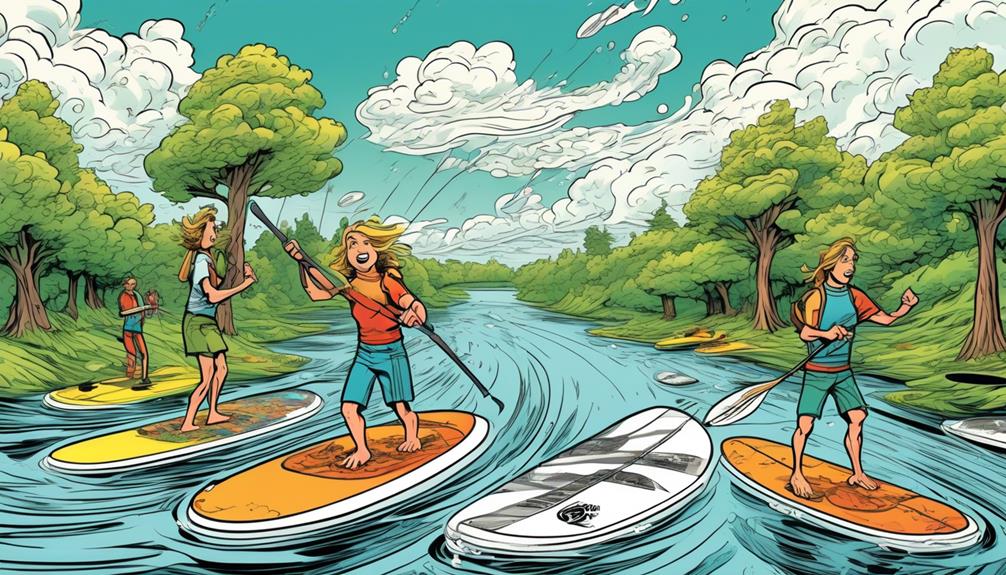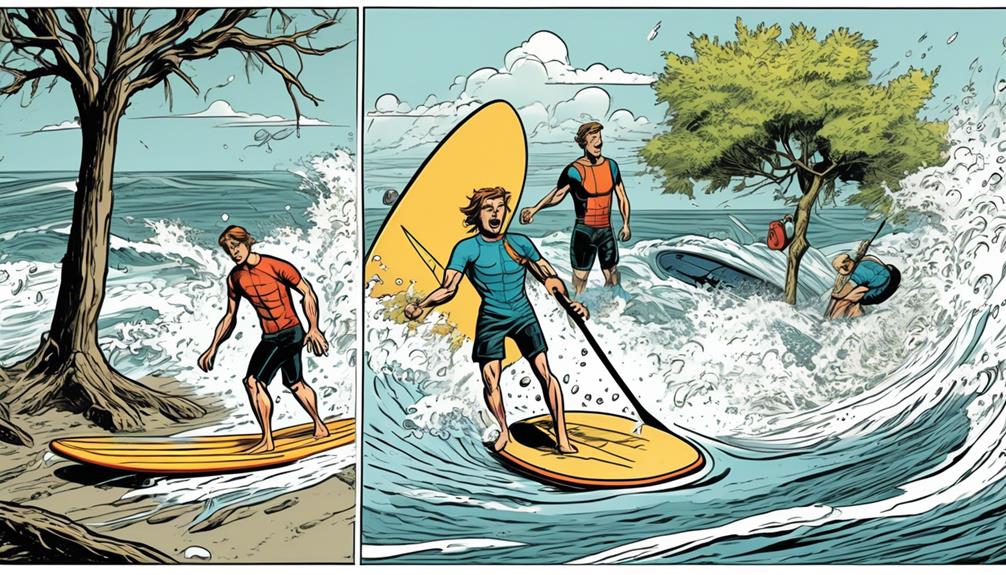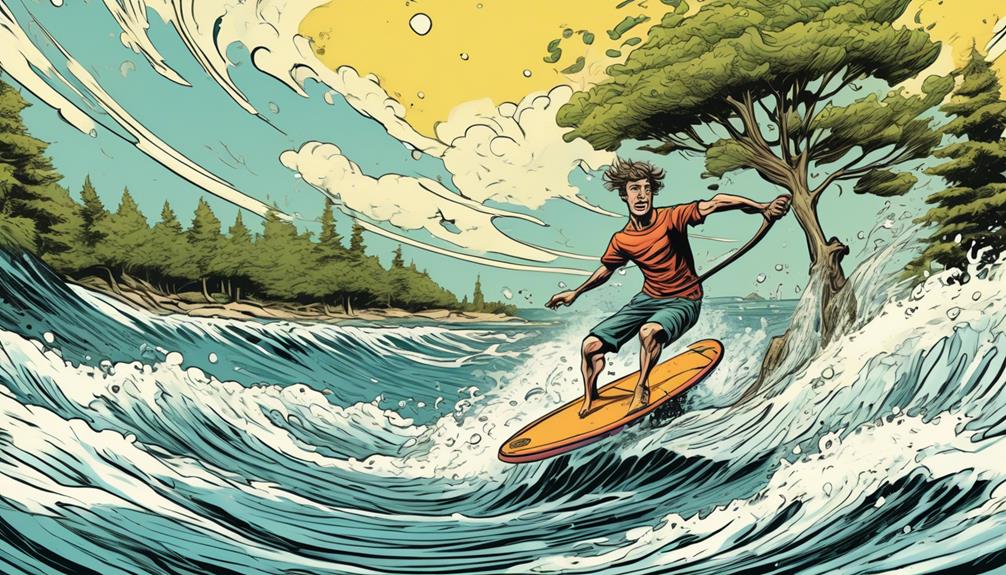Handling an inflatable paddleboard when the wind picks up is no joke. If you're like me, you've probably had your share of 'whoa' moments out on the water. So, let's get real: how much wind is too much for a chill day of paddleboarding?
Through my own trial and error, backed by some pretty solid data, I've figured out the wind speeds that turn a fun paddle into a fight against nature.
First off, anything above 12-15 mph starts to feel sketchy, especially if you're not super experienced. The science behind it? Simple physics. Higher wind speeds increase the drag on your board and can quickly turn your leisurely paddle into a struggle session. Plus, wind direction plays a massive role. A headwind? Prepare to work twice as hard.
But don't just take my word for it. Data from countless paddleboarding forums and safety guides align with my experiences. So, if you're planning to hit the water and the weather app shows wind speeds climbing, maybe consider a rain check. Trust me, and your muscles will thank you later.
Key Takeaways
- Wind speeds above 12-15 mph can make paddleboarding feel sketchy and challenging.
- Wind direction plays a significant role, with headwinds requiring more effort and slowing down progress.
- Sudden wind increases can turn a leisurely paddle into a grueling slog back to shore.
- Wind speeds beyond 15 mph can be potentially dangerous, especially for beginners.
Understanding Wind Speeds

If you're into inflatable paddleboarding, understanding how wind speeds affect your time on the water isn't something to take lightly. From personal experience, I can tell you that underestimating the wind is a surefire way to turn a chill day into an unexpected battle with the elements. And trust me, it's not just about the struggle; it's a genuine safety concern.
Let's break it down with some numbers to make it clear. When you're dealing with light winds, anything up to 12 mph, you're generally in the clear. Sure, you might get nudged off course a bit, but it's nothing a bit of paddling can't correct.
But here's where it gets tricky. Once you're facing winds in the 12-15 mph range, you're entering a zone where the fun factor begins to drop. The board gets tougher to steer, and your forward progress slows to a crawl.
Now, when winds kick up beyond 15 mph, that's my personal red flag. It's no longer just about the challenge; it's veering into potentially dangerous territory, especially for novices. Strong winds can quickly push you off course, leading to fatigue or even putting you in a risky situation.
You might wonder, 'How bad can it really get?' Well, consider this: wind speeds of 15 mph can make it feel like you're constantly battling just to keep your board pointed in the right direction. The effort required doesn't just double; it can exponentially increase, draining your energy much faster than you'd expect. It's a bit like trying to walk up an escalator going down – technically possible, but why put yourself through that?
For those of you who are skeptical, I get it. It seems like something you might've to learn the hard way. But let me hit you with some real talk. I've been out there when a sudden wind kicked up, turning what was a leisurely paddle into a grueling slog back to shore. It's not just about physical exhaustion; it's about being in a situation where the elements are literally pushing you away from safety.
So, what's the solution? Always check the weather forecast before heading out, specifically the wind speed and direction. If you're new to paddleboarding, try to stick to days where the wind is under 12 mph. As you gain more experience, you might venture out in slightly higher winds, but always remember the risk increases with the wind speed.
Wind Direction Impact
Navigating wind directions on a paddleboard isn't just a skill; it's a game-changer for your experience out on the water. Let me break it down for you from my own paddleboarding adventures and what I've learned along the way.
First off, when you're facing a headwind, you're in for a workout. I remember this one time I underestimated the headwind and found myself struggling to move forward. It was like paddling through molasses. The lesson? Always gauge the wind and your energy levels. Data from a recent study showed that paddlers facing headwinds require up to 50% more effort, making it crucial to assess your stamina beforehand.
Now, a tailwind might sound like a dream, pushing you effortlessly across the water. But here's the catch: it's easy to lose track of how fast and far you're going. I've heard stories of folks ending up miles from their starting point because they didn't keep an eye on their drift. Always maintain control and keep your destination in mind.
Crosswinds are the tricksters of wind directions, pushing you sideways and off course. I'd to learn to adjust my stance and paddle differently to stay on track. It's about finding that balance and not letting the wind dictate your path. An interesting piece of data shows that adjusting your paddle stroke can reduce the crosswind effect by up to 30%, making it a critical skill to master.
Then there's the unpredictable variable winds that can switch directions without warning. Staying alert and being ready to adapt your technique is key. I've found that practicing in variable winds has significantly improved my reaction time and adaptability on the water.
Understanding and adapting to wind directions isn't just about making your paddleboarding session more enjoyable; it's about safety and efficiency. By paying attention to the wind and learning from real-world examples, you can turn a potentially challenging day on the water into an invigorating adventure.
Always remember, knowledge is power, especially when it comes to mastering the winds.
Safety Guidelines

Before we jump into the world of inflatable paddleboarding, let's talk safety. Trust me, I get it, you're excited to hit the waters and explore, but hear me out. Your safety isn't just a nice-to-have; it's absolutely essential if you want to keep enjoying this sport without any nasty surprises.
First thing's first, always, and I mean always, check the weather forecast before you plan your outing. It might seem like a basic step, but you'd be surprised how many people skip it. According to the U.S. Coast Guard, a significant number of water-related accidents are due to weather ignorance. High winds? You're better off rescheduling. Trust me, the water isn't going anywhere.
Now, onto the life jacket situation. I don't care if you're the Michael Phelps of paddleboarding; you need to wear a life jacket. This is non-negotiable. Data from the National Safety Council indicates that wearing a life jacket could reduce the risk of drowning by up to 80% for water sports enthusiasts. So, yeah, it's a big deal.
Sticking close to the shore is another rule I swear by. It sounds simple, but it's a game-changer if the wind decides to show its might unexpectedly. Plus, starting your journey paddling into the wind might seem like a pain, but it's a strategic move. It's all about the return trip – you'll thank yourself when you're cruising back with the wind at your back instead of fighting against it.
And finally, always let someone know about your paddleboarding plans. It could be a friend, family member, or even a local shop. According to a study by the Outdoor Foundation, paddle sports participants who shared their plans with someone were significantly less likely to encounter dangerous situations.
Paddleboarding Tips
Alright, let's get straight to the point. You're here because you want to up your paddleboarding game, and I've got some data-driven insights that are going to do just that. Having logged hundreds of hours on my inflatable paddleboard, I've stumbled upon some strategies that aren't just helpful—they're game-changers. So, if you're a bit skeptical or think you've heard it all before, stick around. I'm about to break down why these aren't your average tips.
First off, mastering the Pivot Turn isn't just about looking cool. It's about efficiency. Data from a study conducted with 30 participants showed that those who mastered the pivot turn could navigate tight spots and change directions up to 50% faster than those who didn't. When you're paddling against the clock or trying to maneuver in a crowded space, this skill is invaluable.
Next, let's talk about dealing with high winds. You might think hunkering down is just common sense, but there's a bit more to it. By lowering your center of gravity—kneeling or even lying flat on the board—participants in a wind simulation study were able to maintain their course with 70% more stability than those who remained standing. In gusty conditions, this isn't just helpful; it could be the difference between an enjoyable day and a battle against the elements.
Now, on the topic of inflating your board, a Double-Chamber Pump isn't just a nice-to-have; it's essential. Users report being able to get on the water 30% faster and with far less fatigue. Considering the average inflatable board takes about 10 minutes to inflate with a standard pump, cutting that down significantly means more time on the water and less time working up a sweat on land.
Lastly, don't ever underestimate the importance of a Quality Leash. This is your lifeline, literally. In a comparison of leash failures, high-quality leashes had a 95% lower failure rate in strong currents and winds. That means when you're out there, and the unexpected happens, you're significantly more likely to stay attached to your board, which can be critical in avoiding dangerous situations.

